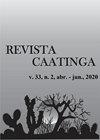多元分析在半干旱地区甜瓜可持续农业生态系统选择中的应用
IF 0.9
4区 农林科学
Q3 AGRONOMY
引用次数: 0
摘要
摘要土壤管理系统,包括耕作和绿色施肥,对于控制线虫和可持续生产至关重要。目的是通过多元分析,为巴西半干旱地区灌溉条件下种植的黄瓜选择可持续的农业生态系统。该长期试验是在Argissolo Vermelho-Amarelo(Ultisol)建立的,具有六个多功能农业生态系统,由三种覆盖作物混合物(1-75%豆类+25%草和油籽;2-25%豆类+75%草和油菜籽以及3-自发植被)和两种类型的土壤管理(免耕NT和耕作-T)组成。目的是评估植物的营养状况、土壤肥力、根和土壤中的线虫种群以及产量。利用多元技术对数据进行分析,从而根据其功能的相似性和复杂性对农业生态系统进行分组。将植物残留物结合到土壤中可以减少线虫种群,但即使在较大的线虫种群下,它们在表面的维持也可以提高肥力和产量。农业生态系统将覆盖作物残留物的不整合与更大的物种组成多样性联系在一起,构成了最复杂的模型,允许不同的环境功能。因此,建议不要将植物残渣直接种植在秸秆中。然而,考虑到不掺入自然植被的结果与掺入商业覆盖作物的结果相似,得出的结论是,这种做法也是可行的,适合半干旱条件。本文章由计算机程序翻译,如有差异,请以英文原文为准。
Multivariate analysis as a tool in the selection of sustainable melon agroecosystems in the semi-arid region
ABSTRACT Soil management systems, including tillage and green manuring, are important for the control of nematodes and for the sustainable production. The objective was to select, through multivariate analysis, sustainable agroecosystems for yellow melon cultivated under irrigated conditions in the Brazilian semi-arid region. The long-term experiment is set up in Argissolo Vermelho- Amarelo (Ultisol) with six multifunctional agroecosystems, composed of the combination of three mixtures of cover crops (1 - 75% legumes + 25% grasses and oilseeds; 2 - 25% legumes + 75% grasses and oilseeds and 3 - spontaneous vegetation) and two types of soil management (no tillage-NT and tillage-T). The purpose was to evaluate the nutritional status of plants, soil fertility, nematode population in roots and soil, and the yield. Data were analyzed with multivariate techniques, allowing the grouping of the agroecosystems based on their similarities and complexity of functions. The incorporation of plant residues to the soil reduces nematode population, but their maintenance on the surface allows the improvement of fertility and yield, even under larger nematode populations. The agroecosystems that associate the nonincorporation of residues from cover crops with larger species diversity in composition constitute the most complex model, allowing different environmental functionalities. Thus, it is recommended not to incorporate the plant residues, planting the melon seedlings directly in the straw. However, considering that the results obtained with the non-incorporation of spontaneous vegetation were similar to those obtained with the incorporation of commercial cover crops, it is concluded that this practice is also viable and adapted to the semi-arid conditions.
求助全文
通过发布文献求助,成功后即可免费获取论文全文。
去求助
来源期刊

Revista Caatinga
AGRONOMY-
CiteScore
2.10
自引率
11.10%
发文量
67
审稿时长
6-12 weeks
期刊介绍:
A Revista Caatinga é uma publicação científica que apresenta periodicidade trimestral, publicada pela Pró-Reitoria de Pesquisa e Pós-Graduação da Universidade Federal Rural do Semi-Árido – UFERSA, desde 1976.
Objetiva proporcionar à comunidade científica, publicações de alto nível nas áreas de Ciências Agrárias e Recursos Naturais, disponibilizando, integral e gratuitamente, resultados relevantes das pesquisas publicadas.
 求助内容:
求助内容: 应助结果提醒方式:
应助结果提醒方式:


